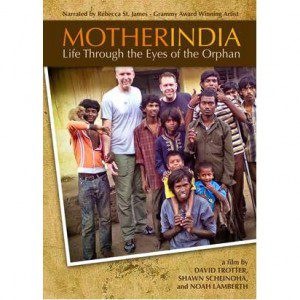One of the greatest diseases is to be nobody to anybody. ~ Mother Theresa
So the story of the new Mother India film is this: two guys went to India. They saw orphans. A lot of them. They returned to the US. They thought they could do more to tell the story of the 31 million orphans in India. And so they did.
Mother India: Life Through The Eyes of The Orphan a new documentary film from Word releasing April 23, 2013, is the result of the passion and talents of David Trotter and Shawn Scheinoha. They returned to India to document the lives of the kids, just a few of the 31 million orphans on the streets of a country whose population is on pace to exceed that of China by 2025. They wanted to show what life is like through the eyes of the orphans. And they succeeded.
Well Done, Not Overdone
Winner of “Best Short Documentary” at the 2012 San Diego Christian Film Festival, Mother India chronicles the adventure of 25 courageous orphans living as a family along the railway in Tenali, India. While Mother India is not for the faint of heart, it doesn’t seek to be intentionally graphic. Maybe it’s the occasional narration by the melodic vocal talents of Rebecca St. James that helps diffuse the awful reality of the kids’ lives. More likely, it’s the story-telling talents of the two men, with a little bit of God’s blessing, that captures the heart of the orphans’ plight without turning your stomach.
The two travel to India without any real plan in place, except to engage orphans. They soon find themselves drawn into a tight-knit family of orphans, complete with a father-figure named Reddy who has become the leader of the rag-tag band of children.
The film depicts the daily life of these kids – how they find food, where they sleep, their means of staying safe, and the habits they rely on to cope with the pain, both past and present.
One thing I was particularly struck by was the prevalence of serious injuries among the children. Nearly 1 out of 3 orphans in India have some such handicap, often received from trying and failing to board a train car to beg for their daily subsistence.
In fact, their injury is among the first things each child is eager to show outsiders. They display it with some sense of pride, a fact that first puzzled me. But then I realized that their physical handicap was also their meal ticket. Unfortunately. The worse their injury seemed to others, the greater the chance they might receive a rupee or two from a compassionate train passenger. In a disturbing way, their weakness became their source of strength.
More than Beggars
And yet there remains a code of honor, a cultural allegiance in their begging system. The children would not simply ask for a handout. Instead, they would extand a hand as they went through the motions of cleaning the floors of the train. In this way, they were seen as “good kids,” as one child put it, worthy of a few rupees. Over the course of the day, they might beg for up to $1 US. If one child fell short, they all pitched in, like a family, to fill the need.
I couldn’t help but note the stark contrast even between the setting in which the men shared their perspectives after their trip and the squalid conditions the kids slept and lived in each day. If the children were lucky, they got to sleep on concrete, covered head to toe with a threadbare blanket to conceal themselves from mosquitoes and other two-footed predators. They brushed their teeth with a finger and brick dust. Many of them have already tested positive for HIV.
Most kids likely contracted HIV through sharing needles, though sexual activity is not at all uncommon. Each of them seemed to have a habit of some sort, a coping mechanism to help numb the pain, both emotional and physical. Some sniffed white-out, some chewed tobacco. Still others shot-up with a watery but mysterious substance which more than one orphan admitted, “I don’t know what it is.”
And yet these kids, for whom no one wants responsibility, don’t seem much different than my own. They want to grow up to be “like regular people.” Their dreams are very humble things. And yet most will not see them realized. Not without help, perhaps from you.
Already Making a Difference
The film ends on a highly positive note as the two men are able to find an adopted home with Harvest India for a three-year-old and seven-year-old deserted by parents who sent them to beg on the streets. From that experience, they discover that the best chance of helping these precious kids is when they are very young.
The longer they are on the streets enjoying “freedom,” the harder it is for them learn that the “freedom” is holding them back.
Parents who watch this film will likely see their own kids in the eyes of these dear souls – except most likely without a missing hand, foot, or eye. It will break your heart. But it should. Our hearts should break for what breaks the heart of God.
Mother India makes a terrific resource for sharing with a church small-group or in a home-group setting. The 49 minute running time fits neatly into such schedules. But I would also suggest the film as tool for parents, teachers, or for homeschooling groups wishing to share a missional mindset with teenage children. I would not recommend it for anything younger than that age level due, not to graphic pictures, but simply to the nature of the mature content. Be sure to screen it first before sharing with kids of any age.
Watch the trailer below and spread the word. There’s a new film in town — Mother India: Life through the Eyes of the Orphan. It’s telling a story you likely don’t know. Not yet. But you will.












